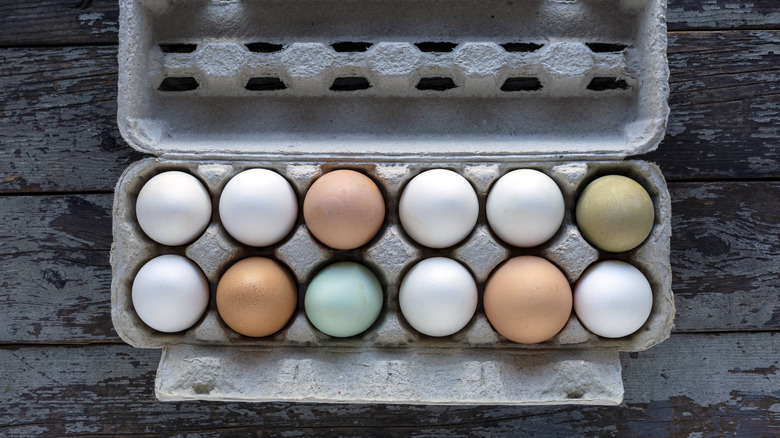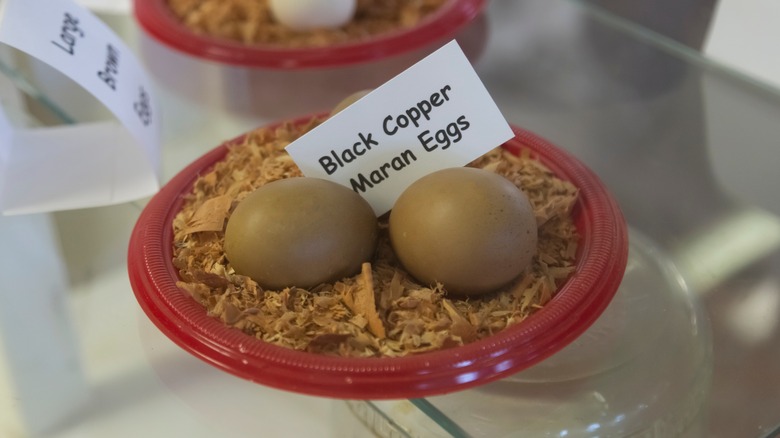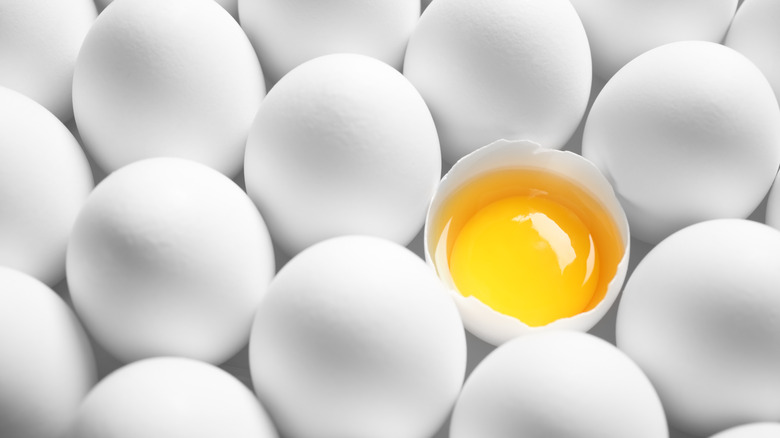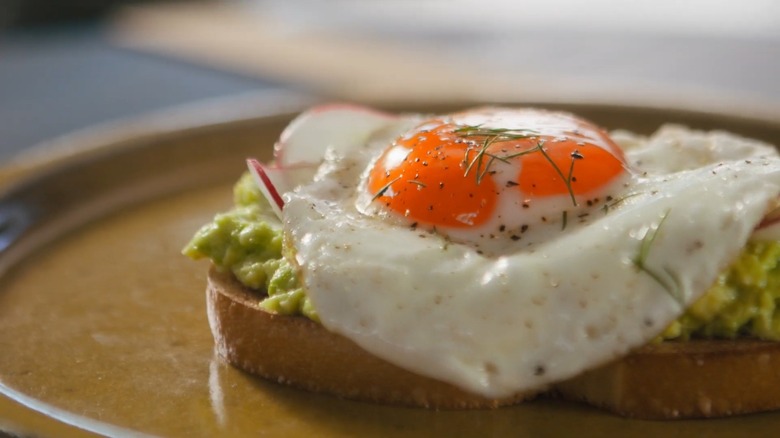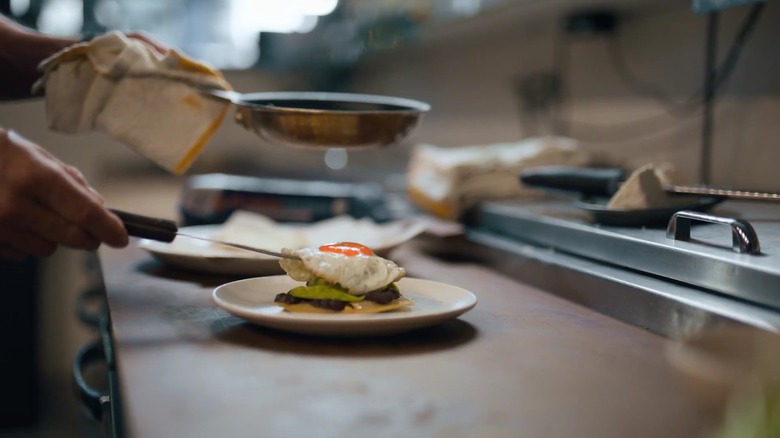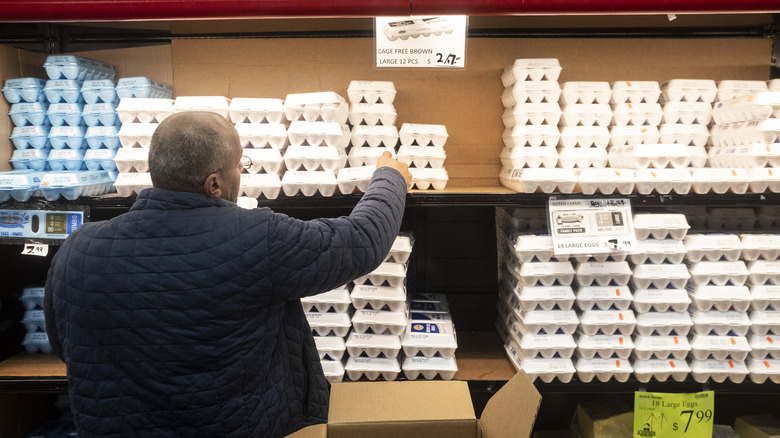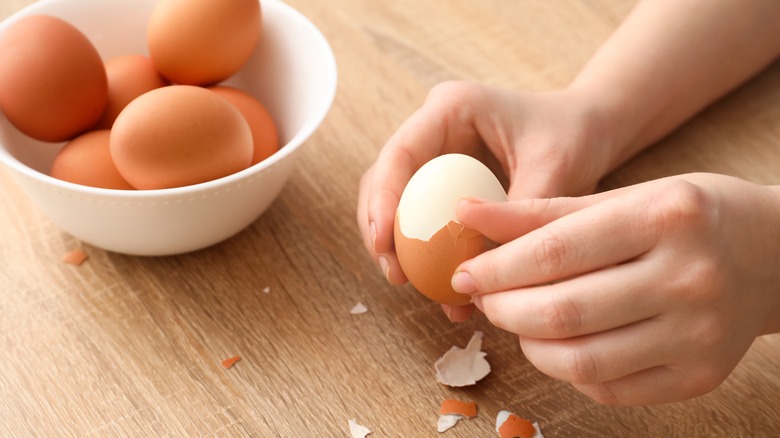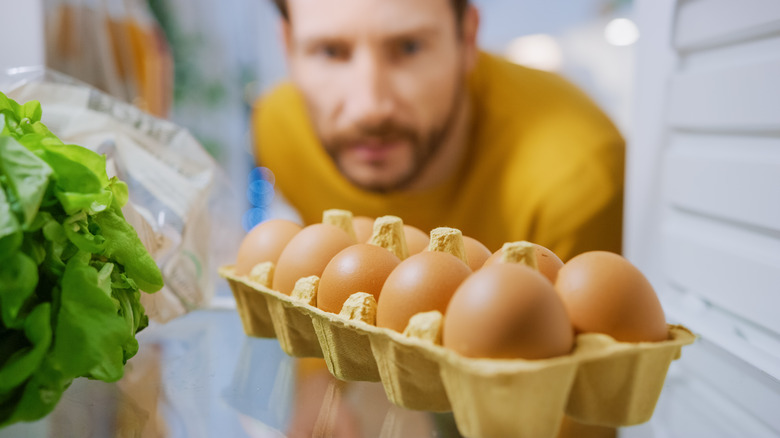What Are Heirloom Eggs And What Do They Taste Like?
With their pastel-colored shells and violently bright yolks, heirloom eggs are a feast for the eyes. Add to this their association with the farm-to-table movement and other, idealized agrarian movements and it's not difficult to see why heirloom eggs are enjoying something of a boom. Several companies now sell these multicolored wonders on a national scale.
Another, consistent feature of heirloom eggs is their cost; some heirloom eggs sell for around $10 per dozen. These high prices look only set to rise as factors including avian flu outbreaks, inflation, and war continue to jack up the cost of all eggs. Such a high price point begs the question, are heirloom eggs really worth it? Each of us will no doubt come to our own conclusion to this. But before we do, we need to understand exactly what heirloom eggs are, how they differ from regular eggs, and what they actually taste like. All of this information is neatly collected here — after reading this article you'll have the requisite knowledge to make an informed decision when it comes to the purchase of heirloom eggs.
What is an heirloom egg?
Otherwise known as heritage eggs, heirloom eggs are eggs laid by heritage chicken breeds. To be defined as a heritage breed, chickens must be from stocks that've been approved by the American Poultry Association and have been established since before the middle of the 20th century. What's more, these chickens must have a slow growth rate compared to modern chicken breeds, be the result of natural mating, and have the ability to survive outdoors for prolonged periods of time.
The differing colors associated with heirloom egg shells arise as a direct result of the chicken's breed. Speckled Legbar hens lay blue-shelled eggs, while the famous Copper Marans hen lays eggs with a dark brown color. Other breeds produce eggs with shells that are white, light brown, and even green. The color of the egg yolks is also notable and, while breed plays a role, it's more about how the chickens were raised, their diets, and how the eggs are processed and stored. Dark orange yolks have become associated with all heirloom eggs and many farmers go to great lengths to ensure their eggs boast this color.
Given heirloom eggs' association with antiquated breeds, some customers assume that the farming practices used to raise them are equally old-fashioned, and involve giving the chickens much pasture time. While many companies do champion free-range heirloom eggs and organic rearing practices, these are by no means guaranteed, especially as marketing terms such as pasture-raised are not regulated.
Heirloom eggs vs regular eggs
The most obvious difference between heirloom eggs and regular eggs is in their appearance. Large-scale commercial farms usually stock modern hybrid breeds, such as the Leghorn and Isa Brown, which have been bred to produce a consistent supply of eggs from minimal feed. The majority of these commercial breeds produce white or brown-shelled eggs, hence why these colors dominate grocery stores' egg selections.
Differing shell colors do not translate into differing characteristics, although it does provide companies with a marketing edge. As executive director of the American Pastured Poultry Producers Association, Mike Badger, explained to The Hutchinson News, "Many farmers have found that adding some color to their egg cartons creates conversation and is a point of differentiation. The quality of the egg is not influenced by the color, of course, still it provides diversity for the small market flocks and their customers."
That being said, some claim heirloom eggs boast a better structure than regular eggs, which tend to be more watery. Others state that the yolks of heirloom eggs have a superior, richer flavor. However, a raw egg's texture, flavor, and appearance are influenced by a huge variety of factors. Refrigeration, for example, turns even the most solid eggs watery given enough time. For this reason, it can be difficult to reliably state which characteristics result from the egg type and which arise from how they're handled.
What does an heirloom egg taste like?
Opinions on heirloom eggs' flavor are divided. Some believe that the deep, golden orange yolks are richer in flavor and larger than those of both organic and conventional eggs. A few even claim that they can discern the minute differences in texture and flavor between different types of heirloom eggs. There are others, however, who dismiss this, saying that vibrantly colored heirloom eggs taste just like normal eggs to most people.
What makes discerning an heirloom egg's true taste all the more complicated is that the appearance of foods has been found to influence people's perception of taste. In other words, people believe an heirloom egg tastes richer because it has a vibrantly colored yolk. The role color plays in our perception of an egg's taste was highlighted in an experiment conducted by J. Kenji López-Alt for Serious Eats. The experiment consisted of two rounds with diners being given a selection of different eggs and asked to pick their favorite both times. In the first round, eggs were presented in their natural color. In the second, all were dyed green. Only one of the eight tasters selected the same egg as their favorite across both rounds, suggesting that it is not the eggs' inherent flavor that draws us toward them.
How to cook with heirloom eggs
Heirloom eggs should be cooked in the same way as any other eggs. All the popular methods, including boiling, poaching, and frying, do not need to be altered when cooking heirloom eggs as they have the same characteristics as regular eggs. As always, cooking time depends on the size of the egg with larger eggs needing more time in the water or on the skillet to reach the best consistency.
However, cooks must take into account how the heirloom eggs' bright yolks will affect the appearance of a dish. When serving fried eggs, these intensely colored yolks are eye-catching, but they're less suited to other dishes. Food writer and stylist Susan Spungen highlighted this to Eater, saying, "Those dark amber eggs really do look good on camera — there it looks natural. If the yolk is really pale yellow, it just doesn't have the same impact. But I made pate sucree with [heirloom eggs], and I couldn't even use it; it looked dyed."
Where to buy heirloom eggs
Although they've become easier to find, heirloom eggs are still nowhere near as ubiquitous as regular eggs. The reason for this is simple: Heritage chickens lay too few eggs to be an economically viable option for many companies. Speaking to Eater, farmer Jamie Skye Bianco explained, "From the position of a market farmer, you might be able to get twice as much selling Marans eggs, but you're really only getting about a quarter of the eggs in a given season." That being said, several companies have come to the fore in recent years, distributing heirloom eggs across the country.
Farmers markets are a great place to purchase heirloom eggs. Prices at these markets vary massively depending on location and brand, but it's not unheard of to pay around $10 for a dozen heirloom eggs. Of course, supporting and interacting with local farmers is a huge benefit of buying heirloom eggs from markets. This also gives buyers a chance to learn about the chickens and how they were raised, and have any questions or concerns swiftly answered.
Nutritional information about heirloom eggs
Contrary to popular belief, there's little evidence to suggest that heirloom eggs are healthier than regular eggs, and experts have stated with certainty that there's no proven nutritional difference between eggs of different breeds. According to the USDA, this means whole, raw heirloom eggs contain 143 calories, 12.6 grams of protein, and 9.51 grams of fat per 100-gram serving, just like any other chicken egg.
A scientific study published in the journal PeerJ compared the eggs of conventionally farmed hens with those produced by free-range hens in Nova Scotia. While the study found no significant differences between the protein content of the two egg groups, it did find a significant difference in the levels of polyunsaturated linoleic acid and cholesterol. The free range eggs had higher levels of linoleic acid, an essential fatty acid, and lower levels of cholesterol. In other words, this study suggests that, while the chicken's breed does not affect an egg's nutritional profile, how the chickens are raised does.
How to store heirloom eggs
As with regular eggs, heirloom eggs should be stored below 40 degrees Fahrenheit. Some people will be able to keep their eggs comfortably in their kitchen or pantry. Others will have to use the fridge. Unused egg yolks or whites that've been removed from the shell must always be stored in the fridge in airtight containers. Eggs can also be frozen for six months as long as the yolk and whites are beaten together before freezing.
If unsure whether an egg is still fresh enough to use, first check the sell-by date. If this doesn't answer the question try the float test by submerging an egg in a large bowl of water. If it floats and loses contact with the bottom of the bowl completely, it's spoiled and should not be eaten. Another easy means of discerning whether heirloom eggs are spoiled or not is to smell them. When cracked, rotten eggs have a very unpleasant and distinctively sulfurous smell. Any egg that smells like this should not be eaten.
